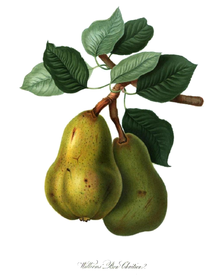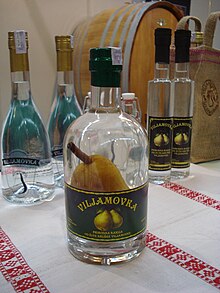| 'Williams' pear | |
|---|---|
 The Williams pear. An 1822 print from the Horticultural Society of London The Williams pear. An 1822 print from the Horticultural Society of London | |
| Genus | Pyrus |
| Species | Pyrus communis |
| Cultivar | 'Williams' |
| Origin | Aldermaston, UK between 1765 and 1770 |
The Williams' bon chrétien pear, commonly called the Williams pear, or the Bartlett pear in the United States and Canada, is a cultivar (cultivated variety) of the species Pyrus communis, commonly known as the European pear. The fruit has a bell shape, considered the traditional pear shape in the west, and its green skin turns yellow upon later ripening, although red-skinned derivative varieties exist. It is considered a summer pear, not as tolerant of cold as some varieties. It is often eaten raw, but holds its shape well when baked, and is a common choice for canned or other processed pear uses.
History

The origins of this variety are uncertain. "Bon Chrétien" (Good Christian) is named after Francis of Paola, a holy man whom King Louis XI of France had called to his deathbed as a healer in 1483. Francis offered the king a pear seed from his native Calabria with instructions to plant and care. Hence the pear tree was called "Good Christian". The Williams pear is thought to date from 1765 to 1770 from the yard of an Aldermaston, England, schoolmaster named John Stair, giving rise to the now-obscure synonyms 'Aldermaston' pear and 'Stairs' pear. A nurseryman named Williams later acquired the variety, and after introducing it to the rest of England, the pear became known as the Williams Pear. However, the pear's full name is Williams' Bon Chretien, or "Williams' good Christian."
In 1799 James Carter imported several Williams trees into the United States, and they were planted on the grounds of Thomas Brewer in Roxbury, Massachusetts. The Massachusetts estate was later acquired by Enoch Bartlett of Dorchester, Massachusetts. Unaware of their origin, Bartlett named the pears after himself and introduced the variety into the United States. It was not realised that Bartlett and Williams Pears were the same until 1828, when new trees arrived from Europe. By that time the Bartlett variety had become vastly popular in the United States, and they are still generally known as Bartlett pears in the US and Canada, although there are about 150 other synonyms worldwide.
Physical description

The pear exhibits a pyriform "pear shape," with a rounded bell on the bottom half of the fruit, and then a definite shoulder with a smaller neck or stem end. Williams are aromatic pears, and have what many consider the definitive "pear flavour". Colours of the pear vary from green (when unripe), to yellow (ripe) and red. Red Bartletts or Williams are very similar to the traditional Williams, aside from ripening to a reddish colour rather than a yellow colour. Red-skinned mutant clones (i.e. "sports") of the Williams are increasing in popularity, including three major varieties in the US: the Max Red Bartlett, the Sensation Red Bartlett, and the Rosired Bartlett. One study of several macrosatellite loci in 63 European Pear (Pyrus communis L.) cultivars did not distinguish Max Red Bartlett and Sensation Red Bartlett from the standard Williams, which was expected since the red mutants were derived from the Williams by mutation. Dozens of other cultivars and hybrids have been created from Williams, created for properties like cold resistance, ripening time, skin colouration, and grafting compatibility.
Best when picked with the internal pressure of the pear is between 110 and 120 kPa (16 and 18 psi), the pear should still be green and relatively hard when picked. Optimum conditions for ripening are in dry shady areas, and ripening usually takes 7 to 10 days from when the pear was picked. As the pear ripens the color will slowly change to a soft yellow and the pear will soften. Commercially produced pears are normally picked and shipped to the stores while green.
Tree
Pear trees are usually productive for 50 to 75 years though some still produce fruit after 100 years. A Bon Chrétien tree planted around 1630 in Danvers, Massachusetts is still producing fruit today.
Height: 4.5–6 m (15–20 ft) with slightly less spread
Flowers: White flowers grouped in a corymb
Blooming time: April–May (in the Northern Hemisphere)
Fruit and seeds: Large, golden yellow skin, brownish red blush, classic shape with smooth, white flesh. Harvest from mid-August to mid-September (Northern Hemisphere).
Leaves: The leaves are simple, glossy green leaves that alternate on the twig. They grow up to 8 cm (3 in) long, are thick with slight midrib curves folding the edges inwards. They have fine teeth on the margin.
Elevation: 300–1,500 m (1,000–5,000 ft)
Habitat: Orchards and landscaping
Production and uses

US pear production
In 1985, this variety represented 80% of US pear production while in 2004 it represented 50% of reported pear production, displaced primarily by the continuing growth of d'Anjou and Bosc pears, both winter pears more tolerant of cold than the Bartlett.
While more pears are sold fresh in the US than processed, Bartlett pears are the primary choice for canned halves, puree, and most pear juice and nectar in the US, comprising about two-thirds of Bartlett production. Bartletts are traditionally known as the canning pear due to their "definitive flavor and sweetness," making them well-suited for many forms of processing.
Named mutants
List of some "sports" or mutants of the Williams pear.
| Date | Originator/Country | Market Name | Mutated From | Assignee | Habit | Flavor | Texture | Color | Plant Patent Number |
| 1908 | /Canada | Russet Bartlett | Golden russet | ||||||
| 1924 | Stephen G. Nye/ Oregon, US | Nye Russet Bartlett | more spicy | firmer | deep yellow with golden russet | ||||
| 1940 | /Australia | Sensation Red Bartlett | |||||||
| 1942 | /US | Eller | |||||||
| 1945 Patented 1 Jul 1947 | Moritz/US | Max-Red Bartlett | Bartlett | MacKelvie | standard | sweeter | finer | red | US plant patent 741 |
| 1948, Introduced 1963 | James W. Sweeney/ California, US | Rosired Bartlett | Bartlett | Fowler Nurseries | Maroon red on picking-ripe fruit. | Plant patent 2012 | |||
| 27 Dec 1977 | Crisafulli/ Montana, US | Bartlett | semi-dwarf | good | red blush | US plant patent 4169 | |||
| 14 Apr 1998 | Biehn/ Oregon, US | Cinnamon | Bartlett | standard | sweeter | russet | US plant patent 10325 | ||
| 26 Feb 2008 | David Lowry/US | Carolina Gold | Bartlett | Associated Fruit | standard | more tart | russet | US plant patent 18515 |
Offspring
For several decades, the Williams pear has been used actively as a parent in the production of new varieties:
| Cross made/Introduced | Originator/Country | 'Marketed/Name | Parent | Other Parent | Plant Patent Number |
| 1896 | C.H. Packham / Australia | Packham (Packhams Triumph) | Bartlett | Uvedals St. Germain | |
| 1901/1913 | Laxton Brothers/Bedfordshire, England | Laxton´s Superb | Bartlett | Beurré Superfin | |
| 1902/1927 | Laxton Brothers/Bedfordshire, England | Laxton´s Satisfaction | Bartlett | Beurré Superfin | |
| ?/? | Laxton Brothers/Bedfordshire, England | Laxton´s Progress | Bartlett | Marie Louise | |
| 1920/? | England | Bristol Cross | Bartlett | Conference | |
| ?/1923 | US | Gorham | Bartlett | Josephine de Malines | |
| 1931/1945 | Robert Patterson/California, US | El Dorado | Bartlett | ? | |
| 1956 | Italy | Butirra Precoce Morettini | Bartlett | Coscia | |
| ?/1964 | New York, US | Aurora | Bartlett | Marguerite Marillat | |
| ?/1974 | England | Beth | Bartlett | Beurré Superfin | |
| 1944/1974 | Robert C. Lamb/New York, US | Highland | Bartlett | Comice | |
| ?/? | England | Merton Pride | Tetraploid Bartlett | Hardenpont | |
| ?/? | Italy | Santa Maria | Bartlett | Coscia | |
| ?/1974 | F.C. Reimer/Oregon, US | Canal Red | Max Red Bartlett | Forelle | |
| 1959/1975 Patented 27 Aug 1974 | William H. Griggs/California, US | California | Max Red Bartlett | Comice | US plant patent 3599 |
| 1965/? | Canada | Harrow Sweet | Bartlett | Purdue 8051 | |
| 1974/1990 | South Africa | Rosemary | Bon Rouge | Forelle | |
| 1985/1997 | S.H. Hjeltnes/Sweden,Norway | Celina(QTee) | Bartlett | Colorée de Juillet | |
| Patented 9 Aug 1988 | Reimer/US | Reimer | Max Red Bartlett | Comice | US plant patent 6245 |
| 1977/2003 | R.L. Bell/Kearneysville, US | Shenandoah | Max Red Bartlett | US 56 112 | |
| Patented 30 Jan 2007 | White/New Zealand | Prem2P | Max Red Bartlett | Nijisseiki | US plant patent 17387 |
| Patented 17 Apr 2007 | Hart/New Zealand | Prem1P | Max Red Bartlett | Nijisseiki | US plant patent 17624 |
| 2007/? | J.R. Breach/Great Britain | Misty Rose | Red Williams | Concorde |
Distilled spirits
The Williams pear is used in making both Poire Williams, a fruit brandy, and Belle de Brillet, an infused cognac.
The pear is also very popular in the western Balkans, where it is distilled into a brandy known as viljamovka, similar to Poire Williams but often with a higher alcohol percentage. Some producers of viljamovka include an entire pear inside each bottle. This is achieved by attaching the bottle to a budding pear tree so that the pear will grow inside it.
Notes
- Valerie Ayres, "Under the Stars?" John and Frances West Family Group newsletter February 2005
- ^ "Pears - Yellow Bartlett - USA Pears". 14 July 2007. Archived from the original on 14 July 2007. Retrieved 20 February 2024.
- ^ Janick, Jules (1 January 2000). Classic Papers in Horticultural Science. Blackburn Press. ISBN 978-1-930665-06-4.
- Wünscha, A., and I. Hormaza. (5 June 2007). "Characterization of variability and genetic similarity of European pear using microsatellite loci developed in apple". Scientia Horticulturae, vol. 113 (1), pp. 37–43, doi:10.1016/j.scienta.2007.02.002. Retrieved 3 October 2007.
- National Clonal Germplasm Repository. " NCGR-Corvallis Pyrus Catalog". (Website). Germ Resources Information Network (GRIN). Retrieved 2 October 2007.
- ^ "The DeLange Home Page". ww82.delange.org. Archived from the original on 8 August 2013. Retrieved 20 February 2024.
- U.S. Department of Agriculture. (September 2004.) "Pyrus Crop Germplasm Committee: Report and genetic vulnerability statement, September 2004". (Website.) Germ Resources Information Network (GRIN), page 5. Retrieved 2 October 2007.
- ^ Silbereisen, Obstsorten-Atlas
- ^ Brooks, Olmo. American Society for Horticultural Science. Vol. 83, page 875
- ^ Brooks, Olmo. American Society for Horticultural Science. Vol. 68
- Brooks, Olmo. American Society for Horticultural Science. Vol. 83
- Brooks, Olmo. American Society for Horticultural Science. Vol. 89
- HortScience Vol. 10(5):477
- ^ HortScience. Vol. 10(5):476
- ^ Brooks, Olmo. HortScience. Vol. 29(9):942-969
- Clark, Finn. HortScience. Vol. 41(5):1101-1133
- Gasic. HortScience Vol. 55(7):1164-1201
- Kleinman, Geoff (3 June 2013). "Review: Belle de Brillet Liqueur - Drink Spirits".
| Pyrus | ||
|---|---|---|
| Cultivars | ||
| Species | ||
| Natural hybrids | ||
| Related topics | ||
